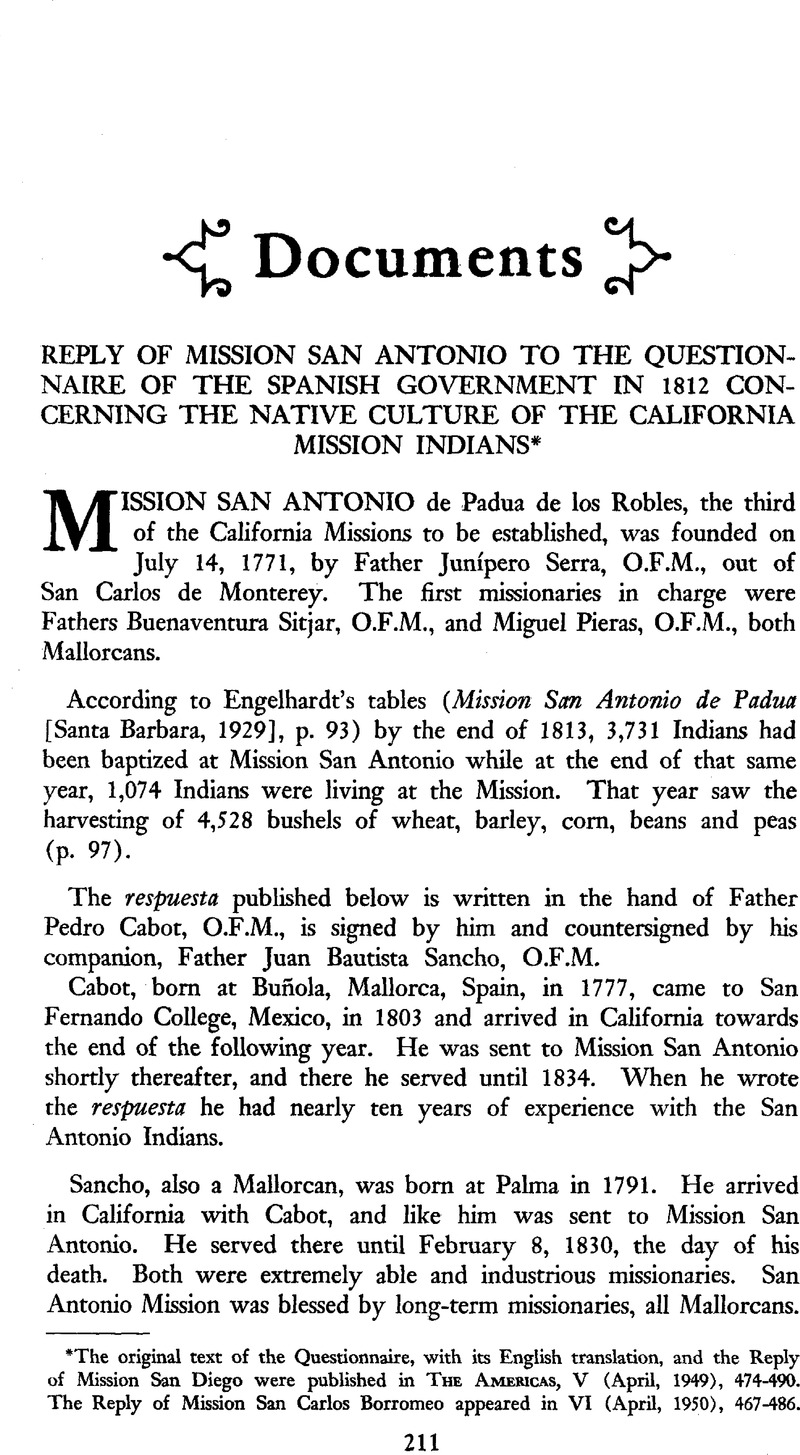Article contents
Reply of Mission San Antonio to the Questionnaire of the Spanish Government in 1812 Concerning the Native Culture of the California Mission Indians*
Published online by Cambridge University Press: 11 December 2015
Abstract

- Type
- Documents
- Information
- Copyright
- Copyright © Academy of American Franciscan History 1953
Footnotes
The original text of the Questionnaire, with its English translation, and the Reply of Mission San Diego were published in THE AMERICAS, V (April, 1949), 474–490. The Reply of Mission San Carlos Borromeo appeared in VI (April, 1950), 467–486.
References
1 The San Antonio Indians belonged to the Salinan linguistic group. See Kroeber, , Handbook of the Indians of California (Washington, 1925)Google Scholar, plate 1, insert. The first missionary in charge, Father Buenaventura Sitjar, became one of the linguists of early California. He composed a “Vocabulario de la Lengua de los Naturales de la Misión de San Antonio, Alta California,” which was published in Shea’s Library of American Linguistics (New York, 1861), Vol. VII Google Scholar. Alexander Taylor’s printed copy of this work is in the Santa Barbara Mission Archive (hereinafter referred to as SBMA).
2 At the end of 1813 Mission San Antonio had 11,000 sheep grazing on its mission lands. Engelhardt, Mission San Antonio, p. 101. Also, original Annual Report, by Fathers Cabot and Sancho for 1813, in SBMA.
3 In 1813 the Mission had 4,045 head of cattle. Engelhardt, op. cit. Also original Annual Report.
4 Fathers Cabot and Sancho arrived at Mission San Antonio in the fall of 1804. The person and character of Father Cabot is described by Robinson, Alfred, Life in California (New York, 1891), p. 91 Google Scholar. As of 1830, he describes him: “Padre Pedro Cabot, the present missionary director, I found to be a fine, noble-looking man, whose manner and whole deportment would have led one to suppose he had been bred in the courts of Europe, rather than in the cloister. Everything was in the most perfect order; the Indians cleanly and well dressed, the apartments tidy, the workshops, granaries, and store-houses comfortable and in good keeping.” Father Cabot’s persistence, industry and ultimate success may be gleaned from his observations under articles 4 and 12 of this respuesta.
5 The catechisms of the Indian languages of California were not submitted for approval to the nearest bishop, who was in Sonora, but rather to the Father Prefect of the Missions or the Presidente. There was no practical method, at any rate, for the Bishop of Sonora to determine their correctness, since the languages of California were not known in Sonora.
6 At Paso Robles. These hot springs are mentioned from time to time in early mission history. Alfred Robinson, op. cit., p. 93, describes the springs referred to in the respuesta. Later on, the first Bishop of California, Fray Francisco Garcia Diego y Moreno, O.F.M. (1842–1846), recommended them. SBMA.
7 According to the annual reports for Mission San Antonio for the four years prior to the composition of this respuesta, the number of the baptisms of infants and the number of deaths of adults and infants, were: 1810: births, 45; deaths, 59. 1811: births, 59; deaths, 78. 1812: births, 53; deaths, 69. 1813: births, 54; deaths, 73. SBMA.
8 At most other missions, breakfast was served after Mass. See subsequent respuestas to be published.
9 The Salve Regina or “Hail! Holy Queen!” This custom was very old in Franciscan missions. In the Franciscan Missions of Florida early in the seventeenth century, Indians from outlying districts would come in to the central mission on Saturdays to hear the Salve Regina sung and remain to hear Mass on Sunday. Geiger, , The Franciscan Conquest of Florida (1573–1618) (Washington, 1937), p. 254.Google Scholar
10 The Alabado with musical notation is reproduced in most of Engelhardt’s individual histories of the California Missions.
11 See Palóu’s Relación Histórica of the Life of Serra, chapter XXVII, concerning the tradition of the San Antonio Indians about the former appearance of Franciscan missionaries among them.
12 Though neither Father Cabot nor Father Sancho was a professional musician, the latter had some musical talent and ability. FatherSilva, Owen Da O.F.M., in his Mission Music of California (Los Angeles, 1941), p. 23 Google Scholar, writes of Father Sancho: “Many of his small, closely written pages, dated Majorca, 1795–96, have been preserved in the Stanford Museum. One page bears the interesting foot-note: ‘I have just finished writing this, the 21st of May, about 11 o’clock at night.’”
13 See Da Silva, op. cit., p. 5.
14 The padres of San Antonio found echoes of their plea two years later in the appeal of Father Mariano Payeras, O.F.M., then Presidente of the California Missions, to the Spanish government. He sought aid to establish a mission at a place called Télame, among the Tulareños of the San Joaquin Valley, about fifty leagues east of Mission San Miguel, where an estimated 4,000 Indians lived. Payeras states the Indians eagerly sought the establishment of a mission among them. He pleaded that the government be “kind enough to cast a loving look at that spacious valley.” In his report for 1817–1818, Payeras stated that “the Padres and the best informed officers consider it necessary to form in the valley of the Tulares another chain of missions and presidios.” See California’s Unbuilt Missions, by Beattie, George William (Los Angeles, 1930), pp. 17–23.Google Scholar
Note: Engelhardt’s translation of the respuesta may be found in his Mission San Antonio de Padua, pp. 30–39. Some of the articles he translated in abridged form. He left out the final note on the Tulares altogether. Kroeber, in a “Mission Record of the California Indians,” in the University of California Publications in American Archaeology and Ethnology (Berkeley, 1908), Vol. 8, No. 1, pp. 18–19 Google Scholar, published a translation of items on language, marriage and musical instruments.
- 2
- Cited by


